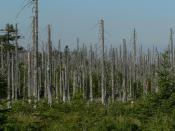The term "acid rain" is used to describe rain, snow or fog that has been polluted by acid in the atmosphere during the water cycle. It is one of the most dangerous and widespread forms of pollution. Acid rain contributes to the damage of not only natural environments, but everyplace it lands upon. It harms bodies of water and many sensitive forest soils. In addition, acid rain accelerates the deterioration of irreplaceable buildings, statues, and sculptures that are part of our nation's cultural heritage. It is also dangerous to the health of people. Normal rain is slightly acidic because carbon dioxide dissolves into it, so it has a pH of about 5.5. As of the year 2000, the most acidic rain falling in the US has a pH of about 4.3. The term pH means a measure of the concentration of hydrogen and hydroxide ions. The pH of a solution measures how acidic it is.
pH values range from zero to fourteen. The lower a substance's pH, the more acidic it is. Seven is considered neutral and measurements below seven are acidic while those above it are basic or alkaline. Every point on the pH scale represents a tenfold increase over the previous number. Thus, pH 4 is 10 times more acidic than pH 5 and 100 times more so than pH 6. Similarly, pH 9 is 1O times more basic than pH 8 and 100 times more basic than pH 7. One example of a neutral acid is pure water. Wine, beer, apples, vinegar, and lemon juice all have a pH lower than 7, and therefore are acids. Sulfur dioxide (SO2) and nitrogen oxides (NOx) is released into the air when fossil fuels such as coal, natural gas, and oil are burned. Coal accounts for most U.S.

![Copper mining and sulfuric acid plant, Copperhill], Tenn. (LOC)](https://s.writework.com/uploads/3/32663/copper-mining-and-sulfuric-acid-plant-copperhill-tenn-loc-thumb.jpg)
